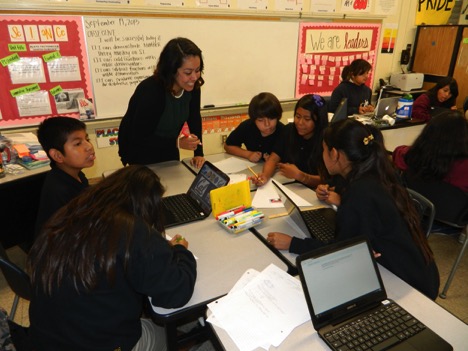After the adoption of Common Core Standards in California in 2010, there has been an increased focus on technology integration in the classroom setting. Students are now supposed to be able to use technology and digital media strategically and capably as a way of fortifying their own 21st century skills. While it can be easy to ask all teachers to integrate the use of technology into their everyday classes, it is necessary to first share the purpose and allow for opportunities for teachers to develop their own digital literacy, as the use of technology was not a superior focus in former teacher education programs. The sooner we bridge the gap between what is expected and what teachers have had exposure to, the sooner students will have access to new opportunities to learn.
I had my first introduction to blended learning during my first year as a teacher. As a new teacher, I thought I could mimic some of my former teachers who were often great at lectures and followed the traditional “I Do, you do, we do” model. Given my lack of exposure to the true integration of technology with instructional purpose, I was hesitant to emerge embrace blended learning. Blended learning, also known as hybrid learning, means a that portion of the traditional face-to-face instruction is replaced by web-based learning, which is often achieved through the use of rotations. Rotations consist of different stations: (a) small group instruction led by the teacher, (b) collaborative or independent practice, and (c) self-directed, online activities. While the use of rotations to create an effective learning environment took practice, I quickly saw the benefits of allowing students to use technology in the classroom as engagement increased along with test scores and productivity.
What do we want students to do with technology?
I remember the first time we were asked during a professional development session what we wanted the outcome of the use of technology to be like in our classrooms. We were all quick to list a number of “tasks” our students would be able to accomplish, ranging from “creating Prezis” to “making videos.” While these were work product results, we came to realize that technology was not a learning outcome, but instead is a tool. This tool allows students to be innovative, start conversations, raise awareness, drive change and so much more. The reality is that integrating technology into the classroom does not need to feel like an added task. Rather, technology should be embedded within instruction as a means of allowing students to be exposed to it and gain the necessary digital literacy skills to succeed in the future.
Technology will not replace great teachers, but technology in the hands of great teachers can be transformative. I experienced many fears with using technology in the classroom at the beginning. I wanted to be purposeful, but I often encountered issues with internet connectivity and with online programs. Yet in the midst of all these different challenges, my students developed problem-solving skills. They learned to collaborate to finish a group project, and they learned to share their thoughts and initiate conversations by publishing their work on blogs. My students gained confidence in themselves as they acquired presentation skills.
In about a week, I will start a new journey as a Digital Learning Instructional Coach at an elementary school, and I find myself inspired and excited to share my own experience and love for the use of technology with other teachers. There is no need to be an expert to technify the classroom. Small steps can lead to a great use of digital learning tools. As I build my own toolkit of resources for the teachers I will soon be helping at my new school site, I wanted to share this post on TeachHub, as it offers a starting point to integrating technology in the classroom in different capacities. Whatever program or site it may be, ask yourself: “What do I want my students to achieve by using this tool?” If all decisions to integrate technology are made with the focus on student learning, there will be no wrong way to use technology.
Our students are meant to be innovators. They are naturally creative and have the advantage of having had exposure to technology at an early age. Let’s work together to unleash their potential and help ensure their schooling experience is transformative by using technology to help personalize their learning and to allow them to meet their 21st century learning outcomes by demonstrating their skills and by being creative instead of simply bubbling in answers.
Alma Renteria
Latest posts by Alma Renteria (see all)
- Rincón Universitario: Cómo Escribir una Narrativa Auténtica para Solicitudes de Universidades, Parte 3 - October 17, 2019
- College Corner: How To Write An Authentic Narrative for College Applications, Part 3 - October 15, 2019
- Rincón Universitario: Cómo Escribir Una Narrativa Auténtica para Solicitudes Universitarias, Parte 2 - October 1, 2019
- College Corner: How To Write An Authentic Narrative for College Applications, Part 2 - September 26, 2019
- College Corner: Cómo Escribir un Relato Auténtico de Solicitudes para la Universidad, Parte 1 - September 4, 2019


Pingback: Why Teachers Needs to Embrace Technology and Add New Tools to Their Toolkits - La Comadre